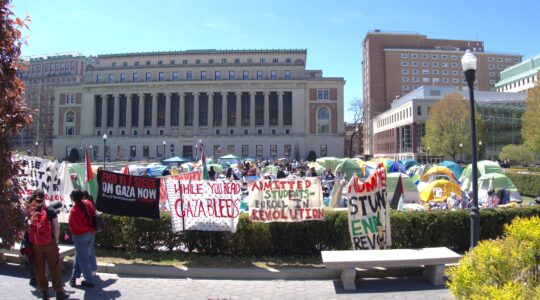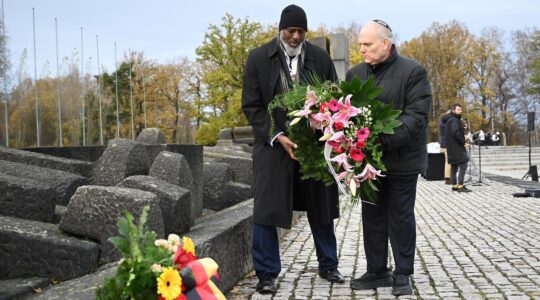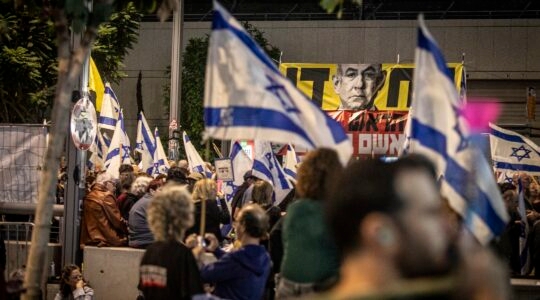(JTA) — The greatest Jewish success story in a quarter century has become unknown to many in less than a generation.
On Dec. 6, 1987, when Soviet leader Mikhail Gorbachev arrived in Washington, more than a quarter-million American Jews — Democrats and Republicans, observant and secular, and individuals representing the entire spectrum of Israeli politics — gathered on the National Mall with a single unified message as old as the Exodus story: “Let our people go!”
“Our people” were the Jews of the Soviet Union who were being discriminated against, deprived of their freedom of expression and religion, and prevented from emigrating. After the Six-Day War, brave Soviet Jews began to risk their careers, loved ones and lives to protest the denial of these freedoms and to advocate for their basic right to immigrate to Israel.
Refuseniks — Soviet Jews who had been denied an exit visa — cried out for help from other Jews. Israeli and American Jewish activists responded, saying “Hineni — Here I am.”
The gathering on that cold December morning 25 years ago was the culminating event of a generation-long struggle by American Jews to win the freedom of their Soviet brethren. Commonly known as the Soviet Jewry movement, it was led by activists who came from every corner of the Jewish community. Their stories and impact continue to resonate with us as Jews and Americans.
The movement’s real engine was at the grass-roots level across America. In the mid-1960s, college students, housewives, dentists, rabbis and teachers orchestrated letter-writing campaigns, local rallies, b’nai mitzvah twinning programs and more. And they persisted in their activism on behalf of Soviet Jews for decades. American Jews from major cities traveled to the Soviet Union with books, messages of support and hidden religious articles.
What was the net result? More than 1 million Soviet Jews became Israeli citizens. Jews from the former Soviet Union transformed intellectual fields in Israel from physics to economics to engineering and the medical sciences — and were recognized with Nobel Prizes no fewer than five times.
Former Soviet Jews have changed the way we work and live through various high-tech innovations. Google, co-founded by Moscow-born Sergey Brin, who immigrated to the United States, might not have been created without the Soviet Jewry movement.
In stark contrast to the lack of political clout and cunning among American Jews during the Holocaust era, this generation of Soviet Jewry activists, reared in the struggle for civil rights for minorities in America, took a universal message of inherent rights and freedom from kitchen tables and university squares to the White House. They confronted political leaders with a moral imperative based on many of the fundamental values, such as religious liberty, that were the foundation of America itself.
In his award-winning book “When They Come for Us We’ll Be Gone,” author Gal Beckerman notes that the Jackson-Vanik Amendment, which tied U.S.-Soviet trade to the basic right of emigration, marked the first time that a fight against the human rights abuses within another sovereign country was directly incorporated into American foreign policy.
In fact, members of the Reagan administration credit activists of the Soviet Jewry movement for personalizing the philosophical differences between the countries, revealing contradictions that served to weaken the foundations of the Soviet Union itself. Within four years of the Freedom Sunday March, the Soviet Union was no more.
And yet this success story has not been integrated into our contemporary Jewish narrative or our understanding of American history. Few under the age of 30 know it ever happened.
We formed Freedom 25 to rectify this incomprehensible situation. Our coalition of more than a dozen nonprofits and Jewish organizations is committed to help refocus Americans generally and North American Jewry specifically on this history and its lessons.
Leading up to the 25th anniversary of the Freedom Sunday March, we will be creating a “virtual march” featuring online events, petitions and educational programming. Our goal is for 1 million people online to celebrate this defining moment in Jewish and human rights history. We also will work collaboratively throughout 2013 to ensure that the movement and its vital legacy become part of classroom curricula and, more important, join the stories we tell our children and grandchildren with pride.
As we celebrate Rosh Hashanah and begin the year 5773, we should remember and appreciate that the struggle for freedom is ongoing. The lessons of the Soviet Jewry movement should inform how we respond to current and future challenges: As a community, we are strongest when we stand together. As a people, we must never stay silent when Jews are in need. As a light to the nations, we must ensure that those rights central to the Soviet Jewry movement — freedom of migration, freedom of information and freedom of conscience — define our activism.
(Daniel Eisenstadt and Michael Granoff are co-chairs of Freedom 25, a coalition focused on promoting the history and lessons of the Soviet Jewry movement to the next generation.)
JTA has documented Jewish history in real-time for over a century. Keep our journalism strong by joining us in supporting independent, award-winning reporting.





